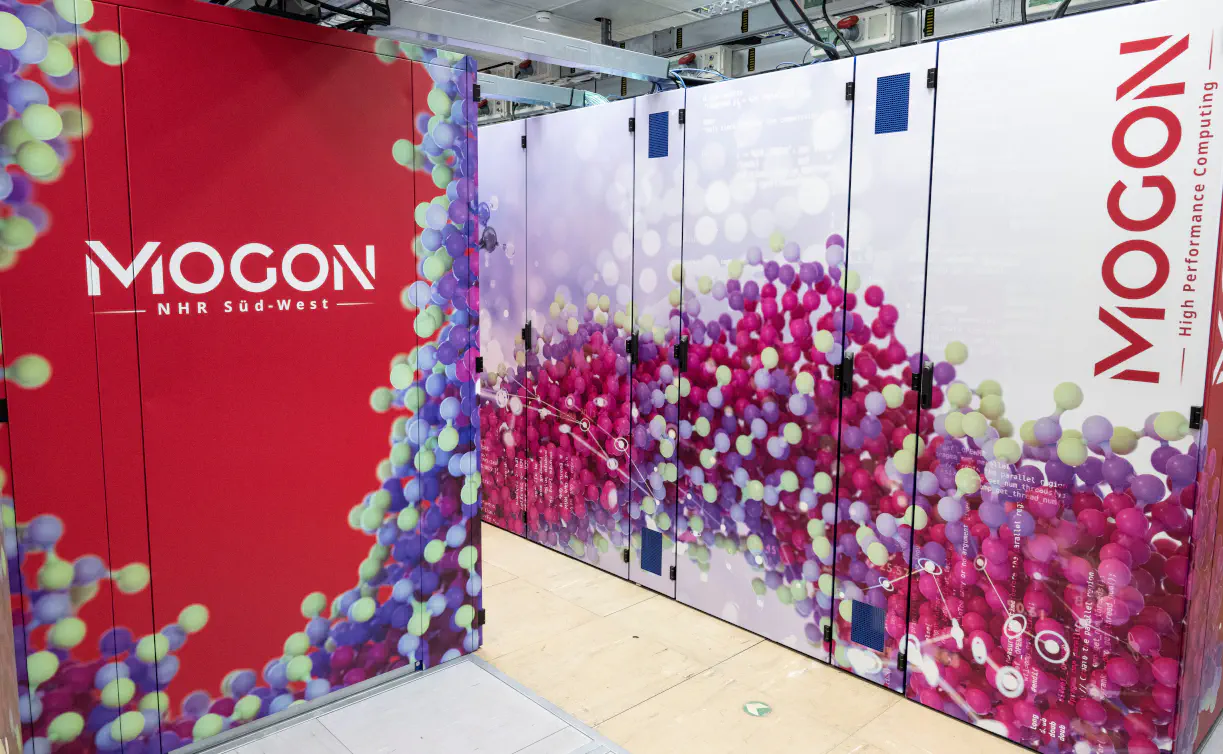What is MOGON?
On this page
MOGON is the High Performance Computing Cluster at the Johannes Gutenberg University (JGU) Mainz and named after the Roman city Mogontiacum, from which the current Mainz has emerged in the course of history.
High-Performance Computing, or HPC for short, utilizes a supercomputer comprised of hundreds or thousands of smaller computers that are connected through a high-speed network and running in parallel to perform calculations too large for a standalone computer to solve or too complex to be solved within a reasonable time frame.
The data center at JGU Mainz operates supercomputers that offer more than 53.000 CPU-cores with a peak performance of 2 PFLOPS (2 quadrillion floating point operations per second) along with 9 PB of storage on a parallel file server for scientists in Rhineland-Palatinate. This allows scientists from various disciplines like high-energy physics, meteorology, life-sciences and many more to achieve their competitive research objectives. Problems that might be solved within days, weeks or months on a desktop computer might take only minutes, hours or days on a supercomputer.
Clusters at JGU Mainz

MOGON NHR Süd-West was acquired in 2022 and has been available since 2023. It features 590 compute nodes, each equipped with two 64 core processors (AMD EPYC 7713).
The ZDV’s MOGON II cluster was acquired in 2016 and 2017. The system consists of 1,876 individual nodes, of which 822 nodes are each equipped with two 10-core Broadwell processors (Intel 2630v4) and 1,136 nodes each with two 16-core Skylake processors (Xeon Gold 6130) and equipped with OmniPath 100Gbits (Fat-tree) are connected. In total this results in around 50,000 cores.
Of the total number of computers, 584 nodes are equipped with 64 GiB RAM (3.2 GiB / core), 732 with 96 GiB RAM (3.0 GiB / core), 168 nodes with 128 GiB RAM (6.4 GiB / core), 120 nodes with 192 GiB RAM (6.0 GiB / core), 40 nodes with 256 GiB RAM (12.8 GiB / core), 32 nodes with 384 GiB RAM (12.0 GiB / core), 20 nodes with 512 GiB RAM ( 25.6 GiB / core), 2 nodes with 1024 GiB RAM (51.2 GiB / core) and 2 nodes with 1536 GiB RAM (48.0 GiB / core), i.e. 5GiB / core on average.
Each node also has a 200GB or 400GB SSD (in the large nodes) for temporary files. At the time of installation, the MOGON II cluster was number 65 on the TOP500 and number 51 on the GREEN500. MOGON II is operated at the JGU by the Center for Data Processing (ZDV) and the Helmholtz Institute Mainz (HIM).
The original MOGON cluster was acquired in 2012 and expanded in 2013 in a second stage to include GPU nodes. The system consisted of 555 individual nodes, each equipped with four AMD CPUs. Each CPU had 16 cores, resulting in a total of 35,520 cores. Each core was clocked at 2.1 GHz. Of the total number of computers, 444 nodes were equipped with 128 GiB RAM (2 GiB / core), 96 nodes with 256 GiB RAM (4 GiB / core) and 15 nodes with 512 GiB RAM (8 GiB / core). Each node also provided 1.5 TB of local hard drive space for temporary files.
In addition to a small GPU training cluster, there are also 13 nodes with 4 GPUs (5-6GB per GPU) per node and 2 nodes with 4 XeonPhis per node. The GPU nodes and the two Phi nodes each have two Intel CPUs with 8 cores and 64GB each.
The user had 1 GBit Ethernet and QDR Infiniband available as a network. Infiniband networking was based on a “full” fat tree.
Additionally, several private sub-clusters from different working groups are managed at the ZDV and made available to the respective users.
The following clusters are private clusters of the Helmholtz Institute Mainz (HIM). Further information on research, funding programs and contact can be found here.
Clover started operating in 2014. It consisted of 320 nodes with 2 Intel Ivybridge processors each. Every CPU had 8 cores, so that the overall system had 5120 cores. The CPUs ran at 2.6 GHz. Each node had 32 GB of RAM (2 GB / core).
The nodes were connected to QDR Infiniband and had access to 200TB of central storage.
HIMster had been calculating since 2011. It consisted of 130 nodes, each with 2 AMD Opteron processors. Each CPU had 8 cores, so that the entire system had 2080 cores. The CPUs were clocked at 2.3 GHz. Each node had 32 GB RAM (2 GB / core), 14 of the nodes had 64 GB RAM (4 GB / core).
The nodes were connected to QDR Infiniband and had access to 557TB central storage with Fraunhofer Filsesystem (fhGFS).